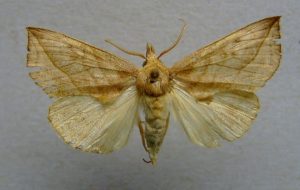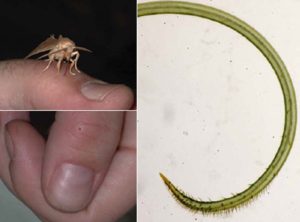Clumsy suckers


I don’t really ‘do’ Lepidoptera, but back in my undergraduate days when I took a Blood Sucking Insects module taught by Mike Lehane I learned about the existence of some very interesting moths that had turned to sucking blood from large mammals.
These insects (Calyptra spp.) are especially interesting because they show evolution in action. Moths typically feed on nectar, which they suck through their proboscis. The subfamily Calpinae, to which the Calyptra species belong “exhibit a broad range of feeding behaviors including those that can be considered ‘piercers’ of fruits or other hosts and ‘tear feeders’ (lachryphagy)” (Zaspel et al 2012).
In order to pierce the tough rind of fruit these moths have evolved a sturdier and sharper proboscis. However, of the seventeen described Calyptra species the males of ten species have been observed piercing mammalian skin and feeding on blood under natural or experimental
conditions.
Unusually among blood feeders, these moths aren’t sucking blood for the protein it contains. Rather they are after the salt. “Typically, male Lepidoptera ‘puddle’ or visit sources of salt more frequently than females and some evidence exists that males transfer salts to the females during mating” (Zaspel et al 2012).
The ability to penetrate the tough rind of fruit is a preadaptation that allowed them to explore explore other sources of nutrients in addition to fruit, i.e. mammalian blood. A 2012 paper on the relationships between Calpinae moths concluded: “Our results support a directional addition of feeding types from nectar feeding to fruit piercing, to skin piercing and blood feeding rather than a directional progression.” (Zaspel et al 2012).
The last words belong to Hans Bänziger who has spent many years studying these moths:
“Several features suggest that in its way of feeding, C. eustrigata is a fairly recently evolved, somewhat clumsy sucker. The moth’s size, light colour and conspicuous flight pattern alarm the host more than any other blood sucking insect, though it does not cause the panic which is said to be aroused by the buzz of warble flies. The moth’s attempts to alight are often perceived even by elephants. Moreover, because of its size, the moth cannot advance into dense fur, which would also hinder the proper working of the piercing mechanism. The deep punctures by the large proboscis would be too painful for medium and small animals, e.g. most carnivores and primates, rodents, etc.; birds; amphibians and reptiles. The latter are also potential predators of the moth. Thus it has a limited host range comprising mainly large mammals of tolerant temperament, little sensibility and defence ability, and with sparse fur: tapir, rhinoceros and other large ungulates. The moth’s predilection for spots which are easy to pierce, such as excoriations and fissures, the often-repeated piercing attempts, frequent change of piercing spots and host, all seem to corroborate further the view that the moth is a “novice” among blood-sucking insects. These considerations fit well into the hypothesis formulated previously that the skin-piercing blood-sucking feeding habit is the last stage in the evolutionary line from nectar-sucking, to fruit-piercing, to skin-piercing in Lepidoptera.”
Read more about these fascinating vampire moths:
Leave a Reply